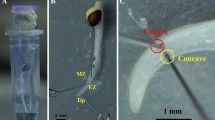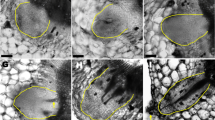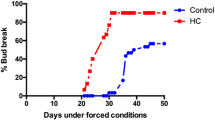Abstract
Cuscuta stem (vines) exhibits two modes of growth—longitudinal elongation forming free-hanging vines, or coiling growth to twine around the host. The elongation zone of free-hanging vine extended up to 160 mm from the stem apex and in vivo growth rate (during 8 h of growth) was maximal in the 20-to-40-mm region. While gibberellic acid (GA3) or fusicoccin (FC) could maintain (GA3) or enhance (FC) the growth rate of apical (10 or 25 mm) segments, indole-3-acetic acid (IAA) (10 μM) induced growth only in subapical (5–160 mm) segments. In vitro growth rate induced by IAA (10 μM) was similar to the in vivo growth rate up to 40 mm. Thereafter, up to 100 mm, IAA induced growth rate exceeded in vivo growth. p ]Subapical segments (∼13 mm) from 5- to 40-mm regions responded to a cytokinin (BA, Z, or iP) or to low IAA (0.1 μM) with curved growth, whereas the segments grew straight in the presence of high IAA (10 μM). Curvature (measured as the angle subtended at the center of the circle of which the segment formed an arc) induced by BA and low (0.1 μM) IAA was greater than either added separately. Besides, segments induced to curve in BA + low-IAA solution could be made to straighten out by transferring to a solution containing high IAA (10 μM) with or without BA. Thus in vivo patterns of straight and coiling growth could be mimicked reversibly in vitro by adjusting the relative concentrations of cytokinin and auxin; low auxin and cytokinin induced coiling growth, whereas high auxin and cytokinin induced straight growth. p ]Beyond 40 mm, BA had no growth-promoting or curvative-inducing effect.Cuscuta vine segments thus showed sequential sensitivity to applied hormones, the apical region (0–25 mm) to GA3, the subapical (5–40 mm) region to BA and IAA and the region beyond (40–160 mm) to IAA alone.
Similar content being viewed by others
References
Cleland RE (1983) Is plant development regulated by change in the concentration of growth substances or by changes in the sensitivity to growth substances? Trends Biochem Sci 7:354–357
Leopold AC, Nooden LD (1984) Hormonal regulatory systems in plants. In: Scott TK (ed), Hormonal regulation of development. II. Encyclopedia of plant physiology, New Series 10, Springer Verlag, Berlin, pp 4–22
Mahadevan S (1983) How the hormone controls the parasite. New Sci 98:164–167
Maheshwari R, Shailini C, Veluthambi K, Mahadevan S (1980) Interaction of gibberellic acid and indole-3-acetic acid in the growth of excisedCuscuta shoot tipsin vitro. Plant Physiol 65:186–192
Nagaiah K, Kumar SA, Mahadevan S (1977) L-phenylalanine ammonia lyase from the lignified and non-lignified regions ofCuscuta chinensis. Phytochemistry 16:667–671
Paliyath G (1979) Investigations on growth, auxin transport, haustoria formation and free amino acids in the angiospermic plant parasiteCuscuta chinensis, Lamk. PhD thesis, Indian Institute of Science, Bangalore, India.
Paliyath G, Maheshwari R, Mahadevan S (1978) Initiation of haustoria inCuscuta by cytokinin application. Curr Sci 47:427–429
Palmer JH (1985) Epinasty, hyponasty and related topics. In: Pharis RP, Reid DM (eds), Hormonal regulation of development. III. Role of environmental factors. Encyclopedia of plant physiology, New Series 11, Springer Verlag, Berlin, pp 139–168
Rajagopal I, Ramasubramanian TS, Shantamani AC, Gunasekhari K, Mahadevan S (1982) Hormonal interactions in dodder (Cuscuta reflexa) development. Abstr. No. 763, 11th Int Conf Plant Growth Subst, Aberystwyth, Wales, July 1982
Ramasubramanian TS, Paliyath G, Rajagopal I, Maheshwari R, Mahadevan S (1988) Hormones andCuscuta development:In vitro induction of haustoria by cytokinin and its inhibition by other hormones. J Plant Growth Regul 7:3
Thimann KV (1977) Hormone action in the whole life of plants. University of Massachusetts Press, Amherst
Trewavas AJ (1982) Growth substances: The limiting factor in plant development. Physiol Plant 55:60–72
Trewavas AJ (1983) Is plant development regulated by changes in the concentration of growth substances or by changes in the sensitivity to growth substances? Trends Biochem Sci 7:354–357
Wright STC (1966) Growth and cellular differentiation in the wheat coleoptile. II. Factors influencing the response to gibberellic acid, kinetin and indole-3-acetic acid. J Exp Bot 17:165–176
Author information
Authors and Affiliations
Rights and permissions
About this article
Cite this article
Rajagopal, I., Ramasubramanian, T.S., Paliyath, G. et al. Hormones andCuscuta development: interaction of cytokinin and indole-3-acetic acid in the growth and curvature of subapical stem segments. J Plant Growth Regul 7, 121–132 (1988). https://doi.org/10.1007/BF02025381
Received:
Accepted:
Issue Date:
DOI: https://doi.org/10.1007/BF02025381




